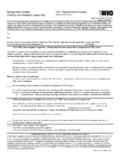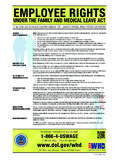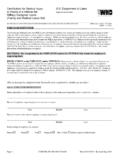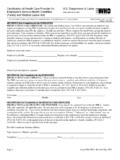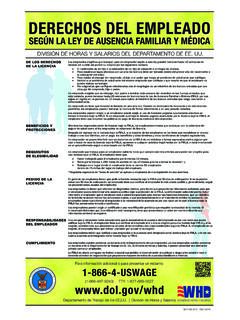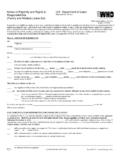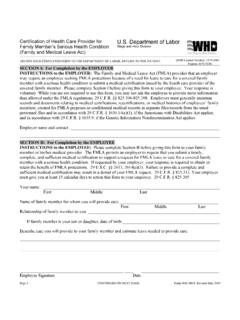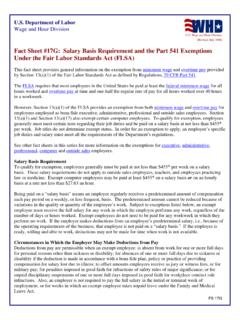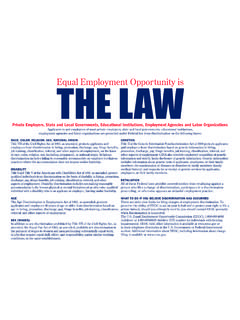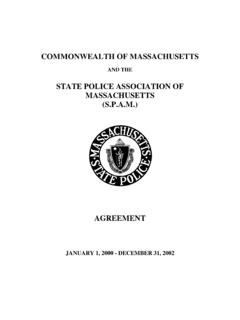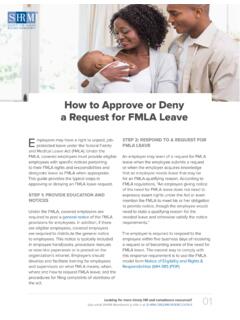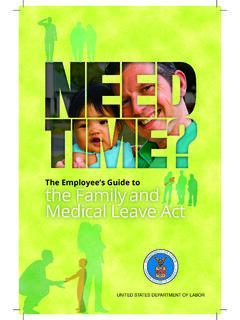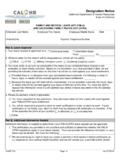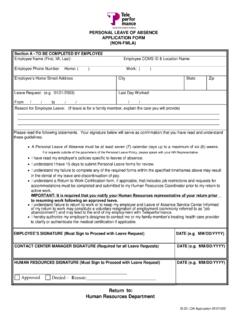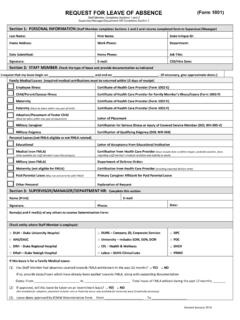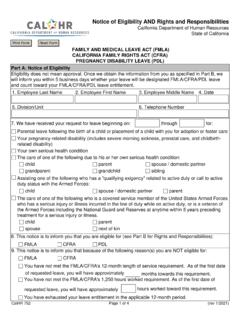Transcription of Fact Sheet #28E: Employee Notice Requirements under the ...
1 Department of Labor Wage and Hour Division (February 2013) Fact Sheet #28E: Employee Notice Requirements under the Family and Medical leave Act Ongoing communication between the Employee and employer is critical throughout the Family and Medical leave Act ( fmla ) process. It is important for the Employee to let his or her employer know as soon as possible each time fmla leave is needed and to respond to questions from the employer designed to determine if a particular leave request is fmla -qualifying. If the Employee fails to provide the employer with enough information to determine whether the leave is fmla -qualifying, the leave may not be protected.
2 The Employee must also comply with the employer s policies for requesting leave unless unusual circumstances prevent him or her from doing so. CONTENT OF THE Employee S Notice The Employee s Notice to the employer may be verbal or written. The first time the Employee requests leave , the Employee is not required to specifically mention the fmla . However, the Employee is required to provide enough information for the employer to know that the leave may be covered by the fmla , and when and how much leave the Employee anticipates needing to take. For example, the Employee may need to provide information showing that the Employee has a condition that causes the Employee to be unable to work, that he or she is needed to care for a qualifying family member who is under the continuing care of a doctor, or that a qualifying family member has been hospitalized overnight.
3 Once approved for a particular fmla leave reason, if additional leave is needed for that reason, the Employee must reference that reason or the need for fmla leave . In all cases, the employer may ask additional questions and/or for a certification to determine if the leave is fmla -qualifying. An employer may require that an Employee provide reasonable Notice to the employer if the need for fmla leave changes while the Employee is out on fmla leave . For example, the employer may require that the Employee notify the employer if the Employee s doctor determines that he or she can return to work earlier than expected or if his or her return to work will be delayed. The employer may also require that the Employee provide periodic updates on his or her status and intent to return to the job.
4 TIMING OF THE Employee S Notice leave that is Foreseeable In general, the Employee must give the employer at least 30 days advance Notice of the need to take fmla leave when he or she knows about the need for the leave in advance and it is possible and practical to do so. For example, if the Employee is scheduled for surgery in two months, the need for leave is foreseeable and at least 30 days advance Notice is required. If 30 days advance Notice is not possible because the situation has changed or the Employee does not know exactly when leave will be required, the Employee must provide Notice of the need for leave as soon as possible and practical. When the Employee has no reasonable excuse for not providing at least 30 days advance Notice , the employer may delay the fmla leave until 30 days after the date FS 28 Enotice is provided.
5 When the Employee could not have provided 30 days advance Notice , but has no reasonable excuse for not providing a shorter period of advance Notice , the employer may delay the fmla leave by what ever amount of time that the Employee delayed in notifying the employer. In the case of fmla leave for a qualifying exigency, the Employee must give Notice of the need for such leave as soon as possible and practical, regardless of how far in advance the leave is needed. For planned medical treatment, the Employee must consult with the employer and try to schedule the appointment at a time that minimizes the disruption to the employer. The Employee should consult with the employer prior to scheduling the treatment in order to arrange a schedule that best suits the needs of both the Employee and employer.
6 Of course, any schedule of treatment is subject to the approval of the treating health care provider. leave that is Unforeseeable When the need for leave is unexpected, the Employee must provide Notice to the employer as soon as possible and practical. It should generally be practicable for the Employee to provide Notice of leave that is unforeseeable within the time required by the employer s usual and customary Notice Requirements . For example, if the Employee s child has a severe asthma attack and the Employee takes the child to the emergency room, the Employee is not required to leave the child to report the absence while the child is receiving emergency treatment. When the Employee does not give timely Notice of unforeseeable leave and does not have a reasonable excuse, the employer may delay or deny the fmla leave .
7 The extent of an employer s ability to delay fmla coverage for leave depends on the facts of the particular case. For example, if it was possible for the Employee to give Notice of the need for leave the same day it was needed, but instead gave Notice two days after the leave began, then the employer may delay fmla coverage of the leave by two days. EMPLOYER S POLICIES FOR TAKING leave In general, the employer may require that the Employee comply with the employer s normal policies for requesting leave . The employer can take action under its internal rules and procedures against the Employee who fails to follow its usual and customary rules for requesting leave , as long as it does not discriminate against employees taking fmla leave . The employer also can choose to waive the Employee s Notice Requirements .
8 ENFORCEMENT It is unlawful for any employer to interfere with, restrain, or deny the exercise of or the attempt to exercise any right provided by the fmla . It is also unlawful for an employer to discharge or discriminate against any individual for opposing any practice, or because of involvement in any proceeding, related to the fmla . See Fact Sheet 77B: Protections for Individuals under the fmla . The Wage and Hour Division is responsible for administering and enforcing the fmla for most employees. Most federal and certain congressional employees are also covered by the law but are subject to the jurisdiction of the Office of Personnel Management or Congress. If you believe that your rights under the fmla have been violated, you may file a complaint with the Wage and Hour Division or file a private lawsuit against your employer in court.
9 For additional information, visit our Wage and Hour Division Website: and/or call our toll-free information and helpline, available 8 to 5 in your time zone, 1-866-4-USWAGE (1-866-487-9243). This publication is for general information and is not to be considered in the same light as official statements of position contained in the regulations. Department of Labor Frances Perkins Building 200 Constitution Avenue, NW Washington, DC 20210 1-866-4-USWAGE TTY: 1-866-487-9243 Contact Us
